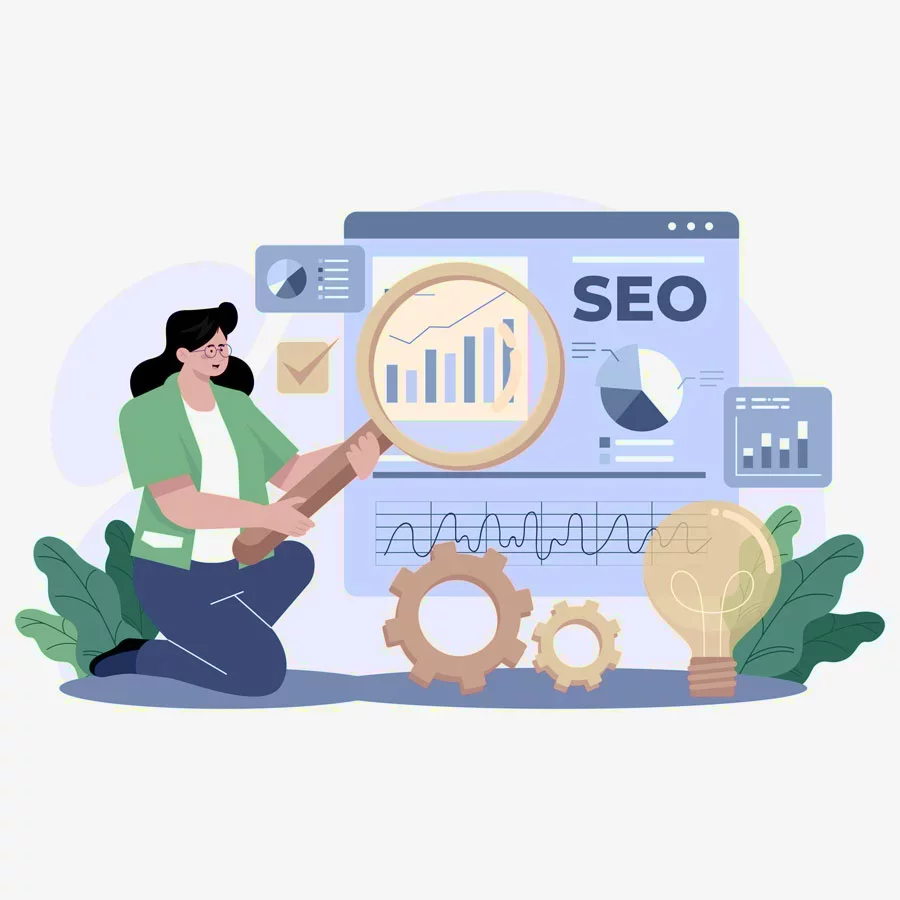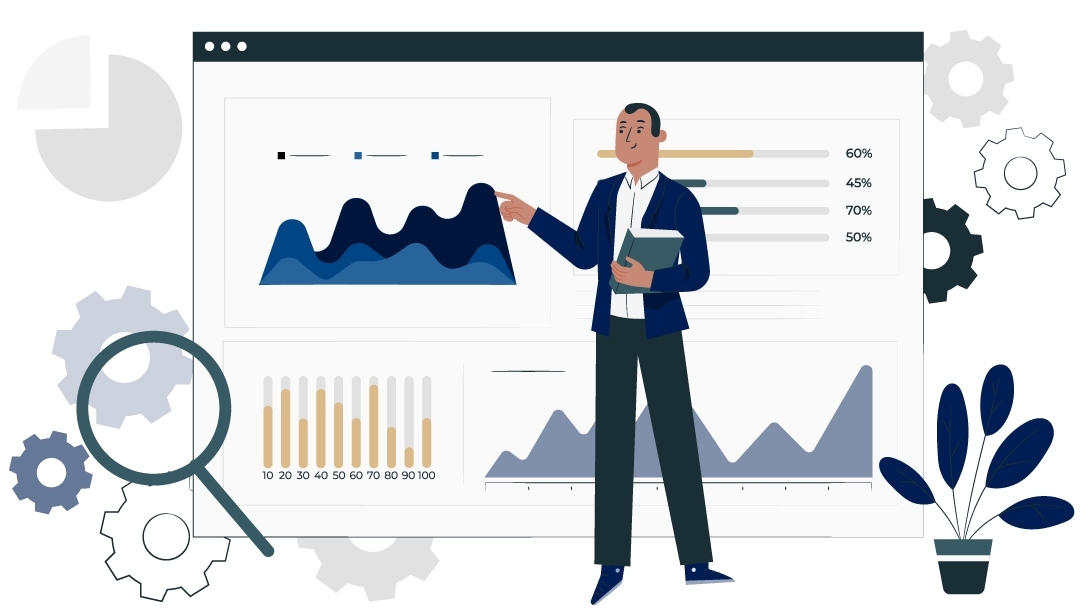Website SEO
SEO, or Search Engine Optimization, is a set of strategies and techniques designed to improve a website’s ranking in search engine results such as Google, Yahoo, and Bing. The ultimate goal of this process is to make your website visible to a targeted audience when they search for keywords related to your products or services.
Appearing on the first pages of search results especially on Google's first page functions like a permanent, cost-free advertisement. This position can generate a continuous stream of targeted visitors to your website, many of whom are likely to convert into actual customers. Therefore, investing in SEO is one of the most strategic ways to achieve sustainable growth, increase sales, and strengthen your brand's presence in the digital space.
Quick Access
Benefits of SEO
-
Improved Brand Recognition: By following SEO principles and achieving higher rankings in search results, your brand gains continuous exposure to users. This repeated presence enhances audience trust and familiarity, increasing the likelihood of converting them into customers. However, successful brand-building requires a more comprehensive digital marketing strategy, of which SEO is only a part.
-
Increased Targeted Traffic: One of SEO’s greatest strengths is its ability to drive real visitors to your website through relevant keywords. This type of natural (organic) traffic, driven by specific user intent, typically has a higher conversion rate and is more effective than many traditional advertising methods.
-
Reduced Advertising Costs: Compared to traditional advertising—such as billboards, print media, or TV SEO is more cost-effective and efficient. Users arrive at your website with a specific intent, which increases the chances of meaningful engagement and actual purchases.
-
Detailed Analytics Capabilities: Tools like Google Search Console and Google Analytics allow you to thoroughly analyze user behavior, click-through rates, bounce rates, and navigation paths. This data enables smarter decision-making and more precise optimization.

Key SEO Factors According to Google
User experience is considered one of Google’s most important ranking criteria. A website that responds quickly and effectively to a user's needs is more likely to appear at the top of search results. Key ranking factors include:
-
Updated, comprehensive, and useful content
-
Title tags that include relevant keywords
-
Backlinks from reputable websites
-
References from specialized sources
-
Proper internal linking structure
-
Mobile compatibility (responsive design)
-
Strong presence on social media platforms
-
Fast page loading speed
-
Use of secure HTTPS protocol
All of these elements should be part of a cohesive and well-integrated SEO strategy.

White Hat vs Black Hat SEO
White Hat SEO involves ethical and legally sound practices that lead to the natural, long-term growth of a website’s ranking. In contrast, Black Hat SEO techniques such as bulk link purchasing or unnatural keyword stuffing carry the risk of penalties and removal from search results.
True success in SEO begins with adhering to technical best practices from the earliest stages of website design. Structuring your site properly and using clean, optimized code creates a solid foundation for high search engine rankings.

On-Page SEO vs Off-Page SEO
-
On-Page SEO refers to optimizing elements within the website such as content, text, images, links, and meta tags. Strategically placing optimized content based on keywords, consistently creating new material, and publishing it at the right time all contribute to improved website performance. The more comprehensive your content, the more traffic you attract, leading to higher rankings.
-
Off-Page SEO encompasses all activities done outside of your website to improve its ranking. This includes acquiring backlinks from other websites. When you publish valuable and engaging content, others may link to it or share it on social media or their own platforms. These external references increase your website's credibility in Google's eyes, boosting your rankings.

Local SEO
As a business owner, it’s more important than ever to understand the significance of local search in Google’s search engine. Google’s algorithms now prioritize local results, meaning that focusing on local SEO is no longer optional it’s an essential component of business growth.
According to statistics, only 34% of small businesses have taken advantage of investing in local search, despite the fact that local searches play a major role in purchasing decisions and can be a sustainable source of real customers.
Local SEO involves a set of on-site and off-site techniques aimed at increasing your visibility in search results based on the user's geographic location. One of the most critical aspects of local SEO is managing your business reputation and user reviews, as these have a significant impact on customer decisions.
Interestingly, the use of the phrase “near me” in Google searches has increased by over 130% since 2015, indicating that users are searching for services and products near their location more than ever before.

SEO for E-Commerce Websites
For e-commerce websites, following SEO best practices is even more crucial. The competition in this space is intense, and being ranked on the first page or ideally at the top of Google’s search results can dramatically impact both traffic and sales. When users can easily find your products or services in search results, the likelihood of them clicking and purchasing rises significantly, directly affecting your revenue.
This makes SEO for e-commerce not just a technical requirement but a strategic element of your sales strategy. Key success factors include optimized coding, fast loading speeds, solid website structure, image optimization, and delivering a smooth, targeted user experience.

WordPress SEO
While building a WordPress website is faster and more convenient than creating a custom-built site, it still requires specialized knowledge and attention to detail to optimize it properly for search engines.
Many ready-made WordPress themes come with basic or generic coding. However, to rank high on Google, you must focus on areas like creating a sitemap, image optimization, link building, producing high-quality content, and choosing the right keywords. Key steps to improve WordPress SEO include:
-
Creating a professional blog focused on target keywords to drive organic traffic
-
Improving loading speed by selecting fast, high-quality hosting
-
Optimizing on-page content based on SEO best practices
-
Crafting engaging titles and optimizing images with appropriate naming, compression, and alt text
-
Publishing relevant, valuable content tailored to user intent and search behavior
WordPress offers strong SEO potential thanks to plugins like Yoast SEO and Rank Math, but simply installing these tools isn’t enough. What truly makes the difference is expertise, strategy, and the correct implementation of SEO principles.

Multilingual and International Website SEO
Optimizing multilingual websites involves applying SEO principles across multiple languages and geographic regions. This delicate and specialized process requires careful planning and attention to both technical and content-related factors.
Key decisions such as choosing a country-specific domain or using subdomains or subdirectories for different languages can directly affect the success of international SEO.
To achieve effective results, SEO optimization must be done individually for each language. This includes producing localized content, professional translation of text, optimizing meta titles and descriptions, and building internal links tailored to each language version.

The best sources of SEO analysis
Before improving your website's search engine ranking, you need accurate insights into your current SEO status. Several online tools can help you evaluate your site’s SEO performance, identify issues, and provide solutions. Some of the most effective tools include:
-
GTmetrix: Ideal for testing page speed and offering technical recommendations to improve website performance.
-
SEO Site Checkup: A comprehensive tool that analyzes both on-page and off-page SEO, clearly highlighting strengths and weaknesses in optimization.
At Webnik, we offer a specialized SEO audit to help you clearly understand your website’s current optimization level and guide your next steps.

What Factors Affect the Cost of SEO?
The cost of SEO varies depending on several factors, including:
-
Domain history and the quality of the website’s code
-
Keyword competition
-
Number and strength of competitors
-
Scope of required tasks (both on-site and off-site)
As a result, SEO pricing differs for each website and keyword. However, many clients expect a fixed price due to a lack of understanding of how SEO works. In reality, SEO covers a broad range of activities and goes beyond improving a site’s rank for just one keyword.
A proper SEO process includes a complete website audit, HTML and code optimization, speed testing, comprehensive on-page SEO, sitemap and schema setup, and submission to Google Search Console and other webmaster tools.

Keyword Classification
In the SEO process, choosing the right keywords plays a critical role in the success of your website. Keywords are generally categorized into three levels based on their competition and difficulty:
-
Easy Keywords (LOW): These keywords have low competition and relatively low search volume. While they may not be highly searched now, investing in them early can position your website as a leader if demand grows and they become trending.
-
Medium Keywords (MEDIUM): These keywords are moderately competitive and require continuous effort and careful planning to rank. The optimization timeline for such keywords typically spans between 6 to 10 months.
-
Difficult Keywords (HIGH): This category includes highly competitive keywords, often targeted by well-established brands or heavily visited websites. High search volume and trend relevance are defining features. Ranking for these keywords on Google usually takes 12 months or more and demands a professional SEO strategy.

SEO Payment Structure at Webnik
At Webnik, our payment model for SEO services is designed to ensure transparency and trust:
-
50% of the total SEO fee is billed at the beginning of the contract.
-
The remaining amount is paid monthly, proportionate to the time required to improve your website’s Google rankings.
This structure serves as a guarantee for quality you continue payments only as you see actual progress and results.
We also offer monthly SEO support services if needed. For details about support fees, feel free to contact us.

SEO Steps
1
Complete site analysis
We conduct a complete analysis of your website to identify strengths, weaknesses, and opportunities for SEO improvemen
2
Technical Optimization
We optimize HTML code and assess page speed to ensure your website meets performance standards.
3
On-Page SEO
We fully implement on-page SEO, define the website’s schema markup and sitemap, and ensure technical compliance.
4
Introduction to Google
We register your site with Google Search Console and Google Analytics to track performance and visibility.
5
Off-Page SEO
We build high-quality backlinks, strengthen domain authority, and engage with relevant external platforms and sources.
6
SEO-Friendly Content Creation
We create targeted, keyword-optimized content tailored to user intent and search behavior.
7
Reporting & Continuous Optimization
We provide monthly progress reports and implement ongoing improvements based on insights and algorithm changes.


Add a comment
Your email address will not be published. Required fields are marked.